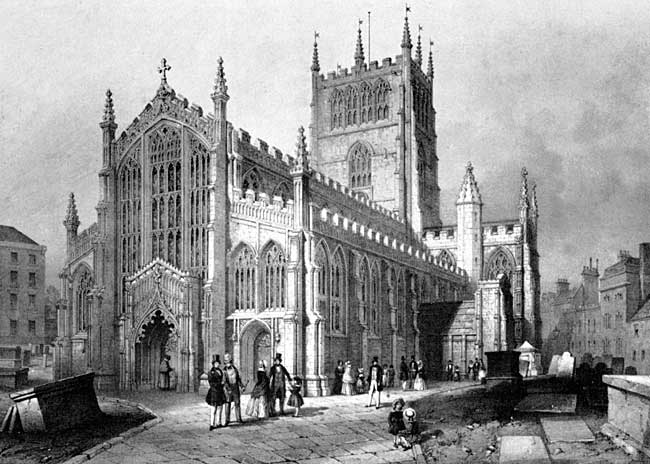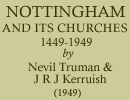St. Mary's Church

St Mary's church, c.1846.
St. Mary's requires a guide book of its own to describe all its glories and its history, and such is obtainable in the church. I can only give a brief outline here of this great fifteenth-century building raised in the best of all Gothic styles, the Perpendicular, when the building and engineering problems which had troubled the earlier masons had all been solved and it was possible so to balance the stresses and strains that solid walls were almost done away, leaving only a wall of glass in which to show off the gay colours of the painted windows. Of late years something of its former colour has been restored, though to the medieval craftsman it would appear to be very grey and sombre. It has splendid proportions and great dignity, its columns shooting straight upwards and melting into the arches without any capitals. The church is dominated by its rood screen (by Bodley and Garner), though the figures which Bodley intended to place on the cross and on pedestals which he provided are yet to come. His, too, is the towering reredos with its tiers of painted and gilded saints which form the climax to the view. The church is all in the same Perpendicular style and took about a century to complete—from 1370 to 1470. The chief things to note are the two canopied tombs in the transepts; a fragment of medieval alabaster (a scene in the life of St. Thomas of Canterbury) in the south chapel, where is also a good Victorian terracotta relief by Tinworth; the Jacobean altar in the north chapel; the jolly heraldic lion and unicorn at the west end; the regimental flags; the great bronze doors of the south porch put up in 1905 and reminiscent of many splendid Italian church doors; the Renaissance tablet to John Plumptre, 1719, in the north transept; Fra Bartolomeo's painting of Our Lady and the Christ Child; and some of the stained glass.
Medieval vestries are rather rare, and that in St. Mary's is apt to be overlooked. It should not be missed. Built in 1473, it was modernised and added to in Stuart times and has a beautiful ceiling with a decorative cornice and ceiling-rose. The window is accommodated to the ceiling by a clever use of a large shell in plaster dating from the late eighteenth or early nineteenth century, and there is a vestry clock of 1807. The collection of plate begins with a paten of 1638 and one of ten years later, and there is a great alms dish weighing 70 ounces, which was made in 1808, besides a number of other items, old and new. The altar ornaments of silver and coloured enamel in the north transept are good examples of twentieth-century design.
The possession of a permanent bishop's throne at the end of the choir stalls is a curious "illegality", since it was intended for the use of the bishops suffragan, who are not entitled to such a dignity. In the time of Henry VIII suffragan bishops with English towns for title were created for the first time, and Richard Barnes was so appointed for Nottingham in 1537. There was no other until 1870 and 1877 when two were successively made, but owing to the trouble and confusion that arose over the duplication of this title with that of the Roman Catholic Bishops of Nottingham (whose prior claim dated from 1845) it was abandoned and our suffragans were bishops of Derby until the division of the diocese.
Of wall tablets, we may notice one commemorating a Mr. Berdmore who was dentist to King George II and did much to modernise his profession, particularly in the provision of artificial teeth; a well-designed one to Anne Hollings; and the remains of the tomb of the Earl of Clare in the south transept.
In former days both arches leading to each transept were screened off and within the double chapels thus created were the altars of the Trinity and St. John Baptist (north) and of Our Lady and St. Lawrence (south). West of the rood, against the north pier, was that of St. Luke, and its companion across the aisle was to St. Catherine. A chapel of St. James was reached through the north door now leading to the outside. It is stopped by masks of Richard II and his Queen.
The best stained glass is the range of windows by Kempe in the south aisle over the porch—a series of soldier-saints displaying that rich jewelling typical of Kempe's work. The vast east window in the south transept is much influenced by the Pre-Raphaelite painters. Its subject is the Parables, and it is a pleasant occupation to discover which story each scene depicts. It has good colour boldly used, and the garments of the various people are beautiful in pattern and shape. The east window of the south chapel (by Burlison and Grylls) shows scenes from the lives of the patron saints of a young bride (Katherine Mary Monica Wade-Dalton) who died within a week of her marriage within these walls. You can sec her in her wedding dress at the foot
of the w indow. Those who chose the subjects are to be congratulated
on taking advantage of the circumstances to produce an uncommon window.
If you turn to the west end you will see an example of fifteenth-century engineering skill. Visible wall support amounts to almost nothing, and the wall appears to be made up of nothing more substantial than glass. Though built in the nineteenth century to replace a Classical west front, it follows the lines of the medieval design.
